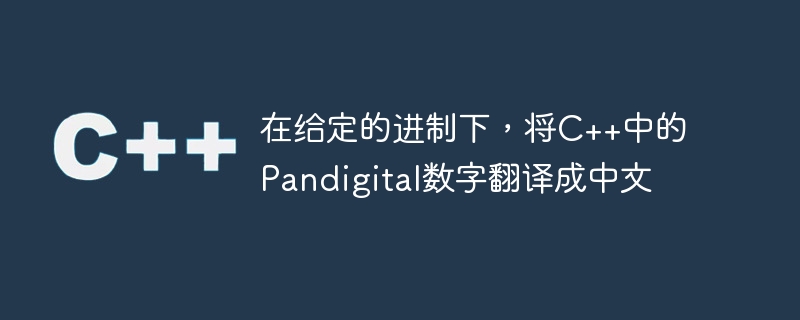指定された基本システムの下で C++ のパンデジタル数値を中国語に翻訳します
- WBOYWBOYWBOYWBOYWBOYWBOYWBOYWBOYWBOYWBOYWBOYWBOYWB転載
- 2023-08-30 08:01:101315ブラウズ

0 から基数 B までのすべての桁を含む数値は、その基数の合計数と呼ばれます。ただし、一部の数字は 1 から 9 までの数字を持ち、ゼロを含まない全桁数字と呼ばれます。完全な数値の例には、0123456789、0789564312 などがあります。
このチュートリアルでは、数値と基数が与えられ、その数値が指定された基数の完全な数値であるかどうかを確認する必要がある問題について説明します (例: -
Input: num = “9651723467380AZ”, base = 10 Output: YES Explanation: num contains all the digits in the base 10 i.e from 0 to 9, so it is a pandigital number. Input: num = “130264ABCDE745789”, base = 16 Output: NO Explanation: num does not contain F(15) which is in the base 16 i.e from 0 to 15, so it is not a pandigital number.#)。 # #解決策を見つけるためのアプローチこの問題を解決するには、一意の値を保存する必要があるため、Set を使用してセットに各桁を挿入します。
- Traverse一度に各文字を取得して、文字列を調べます。
- 次に、要素が整数かアルファベットかを確認します。
- alphabet を入力し、2 桁を表すためにアルファベット上の位置に 10 を追加します。
- 値をセットに保存します。
- トラバース後、セットのサイズがbaseと等しいかどうかを確認します。
上記のアプローチのCコード
#include<bits/stdc++.h>
using namespace std;
int main(){
int base = 10;
char n[] = "9651723467380AZ";
// Declaring set to store unique values.
set<int, greater<int> > s;
// Traversing through the string.
for (int i = 0; i < strlen(n); i++){
// Checking if element is Integer.
if (n[i] >= '0' && n[i] <= '9')
s.insert(n[i]- '0');
// Checking if element is alphabet.
else if (n[i] - 'A' <= base - 11)
s.insert(n[i] - 'A' + 10) ;
}
// Checking if all the digits are present.
if(s.size()==base)
cout<< "YES";
else
cout<< "NO";
return 0;
}出力 YES
結論このチュートリアルでは、数値と基数が与えられた問題について説明しました。数値が完全な数値であるかどうかを確認する必要があります。値をセットに挿入し、そのサイズをカーディナリティに対してチェックすることで、この問題を解決する簡単な方法について説明しました。この問題については、C、Java、Python などのプログラミング言語を使用して実行できる C プログラミングについても説明しました。このチュートリアルがお役に立てば幸いです。 以上が指定された基本システムの下で C++ のパンデジタル数値を中国語に翻訳しますの詳細内容です。詳細については、PHP 中国語 Web サイトの他の関連記事を参照してください。
声明:
この記事はtutorialspoint.comで複製されています。侵害がある場合は、admin@php.cn までご連絡ください。
前の記事:C と C++ の違いは何ですか?次の記事:C と C++ の違いは何ですか?

